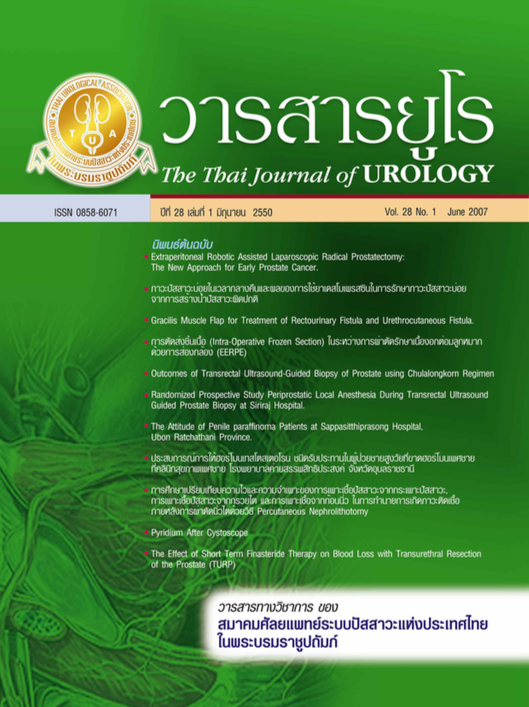Extraperitoneal Robotic Assisted Laparoscopic Radical Prostatectomy: The New Approach for Early Prostate Cancer
Keywords:
radical prostatectomy, prostate cancer, robotic prostatectomy, impotencyAbstract
Introduction: Robotic Assisted Laparoscopic Radical Prostatectomy (RALRP) for treatment of localized prostate cancer has been shown to provide the best surgical outcomes in terms of potency and continence. Most RALRP has been done using transperitoneal approach at the expense of higher risk of small bowel injury, ileus and steep trendelenburg position during the procedure. With the use of extraperitoneal approach, those potential complications can be reduced. The program of Extraperitoneal Robotic Assisted Laparoscopic Radical Prostatectomy (EP-RALRP) was started at the Siriraj Hospital. Early result of the authorûs experience was evaluated.
Objective: To evaluate the feasibility of Extraperitoneal Robotic Assisted Laparoscopic Radical Prostatectomy (EP-RALRP) done at Siriraj Hospital.
Materials and methods: 6 patients with localized prostate cancer were undergone Extraperitoneal Robotic Assisted Laparoscopic Radical Prostatectomy (EP-RALRP). Perioperative data was evaluated and reported.
Results: Of 6 patients, 5 patients were undergone EP-RALRP with nerve sparing technique. There was no conversion to RALRP or Laparoscopic Radical Prostatectomy. Mean operative time was 135 minutes. The average blood loss was 450 mls. Mean catheterization time and hospital stay were 6.8 days and 5.4 days, respectively. There was no complication in all patients.
Conclusion: Our early experience has shown that EP-RALRP is feasible and safe. The operation should be encouraged among robotic surgeons as the patients can gain benefit from lower risk of intra- abdominal organ injury and lesser degree of trendelenburg position.
References
Ahlering TE, Eichel L, Edwards RA, Lee DI, Skarecky DW. Robotic radical prostatectomy: a technique to reduce pT2 positive margins. Urology. 2004; 64(6):1224-8.
Menon M, Hemal AK. Vattikuti Institute prostatectomy: a technique of robotic radical prostatectomy: experience in more than 1000 cases. J Endourol. 2004; 18(7): 611-9.
Srinualnad S. Early Experience of Robotic Prostatectomy.
Srinualnad S. Robotic Prostatectomy in Early Prostate Cancer.
Srinualnad S. Minimally Invasive Surgery for Early Prostate Cancer.: National Cancer Conference, Sufficiency Phiosophy in Oncology: From Treatment to Prevention.
Atug F, Castle EP, Srivastav SK, Burgess SV, Thomas R, Davis R. Positive surgical margins in robotic-assisted radical prostatec- tomy: impact of learning curve on oncologic outcomes. Eur Urol. 2006; 49(5): 866-71.
Bhandari A, McIntire L, Kaul SA, Hemal AK, Peabody JO, Menon M. Perioperative complications of robotic radical prostatectomy after the learning curve. J Urol. 2005; 174(3): 915-8.
Herrell SD, Smith JA, Jr. Robotic-assisted laparoscopic prostatectomy: what is the learning curve? Urology. 2005; 66(5 Suppl): 105-7.
Sahabudin RM, Arni T, Ashani N, Arumuga K, Rajenthran S, Murali S, et al. Development of robotic program: an Asian experience. World J Urol. 2006; 24(2): 161-4.
Savera AT, Kaul S, Badani K, Stark AT, Shah NL, Menon M. Robotic radical prostatectomy with the ùùVeil of Aphroditeûû technique: histologic evidence of enhanced nerve sparing. Eur Urol. 2006; 49(6): 1065-73.
Seifert AL, Huntington TR. Laparoscopic radical prostatectomy in a community hospital without robotic assistance. Urology 2006; 68(4): 831-3.
Tewari AK, Rao SR. Anatomical foundations and surgical manoeuvres for precise identification of the prostatovesical junction during robotic radical prostatectomy. BJU Int. 2006;98(4): 833-7.
Tseng TY, Kuebler HR, Cancel QV, Sun L, Springhart WP, Murphy BC, et al. Prospective health-related quality-of-life assessment in an initial cohort of patients undergoing robotic radical prostatectomy. Urology. 2006; 68(5): 1061-6.
Zorn KC, Gofrit ON, Orvieto MA, Mikhail AA, Zagaja GP, Shalhav AL. Robotic-assisted laparoscopic prostatectomy: functional and pathologic outcomes with interfascial nerve preservation. Eur Urol. 2007; 51(3): 755-62.
Srinualnad S, Udompunturak S. Extraperitoneal laparoscopic radical prostatectomy: early experience in Thailand. Asian J Surg. 2007; 30(4): 272-7.
Joseph JV, Rosenbaum R, Madeb R, Erturk E, Patel HR. Robotic extraperitoneal radical prostatectomy: an alternative approach. J Urol. 2006; 175: 945-50.
Atug F, Castle EP, Woods M, Srivastav SK, Thomas R, Davis R. Transperitoneal versus extraperitoneal robotic-assisted radical prostatectomy: is one better than the other? Urology. 2006 ; 68(5): 1077-81.
Atug F, Thomas R. Transperitoneal versus extraperitoneal robotic-assisted radical prostatectomy: which one? Minerva Urol Nefrol. 2007; 59(2): 143-7.
Brown JA, Rodin D, Lee B, Dahl DM. Transperitoneal versus extraperitoneal approach to laparoscopic radical prostatectomy: an assessment of 156 cases. Urology. 2005; 65(2): 320-4.
Eden CG, King D, Kooiman GG, Adams TH, Sullivan ME, Vass JA. Transperitoneal or extraperitoneal laparoscopic radical prostate- ctomy: does the approach matter? J Urol. 2004; 172(6 Pt 1): 2218-23.
Erdogru T, Teber D, Frede T, Marrero R, Hammady A, Seemann O, et al. Comparison of transperitoneal and extraperitoneal laparoscopic radical prostatectomy using match-pair analysis. Eur Urol. 200; 46(3): 312-9.
Hoznek A, Antiphon P, Borkowski T, Gettman MT, Katz R, Salomon L, et al. Assessment of surgical technique and perioperative
morbidity associated with extraperitoneal versus transperitoneal laparoscopic radical prostatectomy. Urology. 2003; 61(3): 617-22.
John H, Schmid DM, Fehr JL. [Extraperitoneal radical prostatectomy Da Vinci]. Actas Urol Esp. 2007; 31(6): 580-6.
Madeb R, Golijanin D, Knopf J, Vicente I, Erturk E, Patel HR, et al. Patient-reported validated functional outcome after extraperitoneal robotic-assisted nerve-sparing radical prostatectomy. Jsls. 2007; 11(3): 315-20.
Porpiglia F, Terrone C, Tarabuzzi R, Billia M, Grande S, Musso F, et al. Transperitoneal versus extraperitoneal laparoscopic radical prostatectomy: experience of a single center. Urology. 2006; 68(2): 376-80.
Poulakis V, Ferakis N, Dillenburg W, Vries R, Witzsch U, Becht E. Laparoscopic radical prostatectomy using an extraperitoneal approach: Nordwest hospital technique and initial experience in 255 cases. J Endourol. 2006; 20(1): 45-53.
Poulakis V, Skriapas K, de Vries R, Dillenburg W, Witzsch U, Becht E. Vesicourethral anastomosis during endoscopic extraperitoneal radical prostatectomy: a prospective comparison between the single-knot running and interrupted technique. Urology. 2006; 68(6): 1284-9.
Srinualnad S, Nualyong C. Nerve-sparing laparoscopic radical prostatectomy at Siriraj Hospital. J Med Assoc Thai. 2007; 90(4): 730-6.


